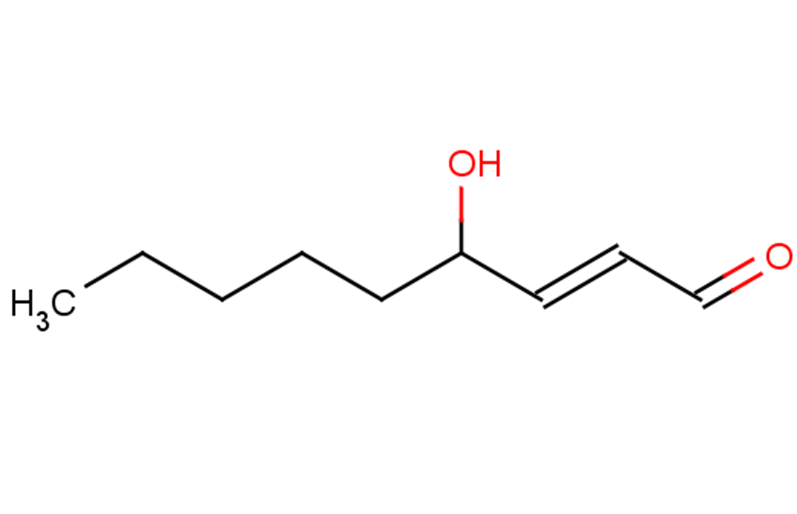
4-Hydroxynonenal
CAS No. 75899-68-2
4-Hydroxynonenal( 4-HNE )
Catalog No. M22673 CAS No. 75899-68-2
4-Hydroxynonenal (4-HNE) is an oxidative/nitrosative stress biomarker. It is a substrate and an inhibitor of acetaldehyde dehydrogenase 2 (ALDH2).
Purity : >98% (HPLC)
 COA
COA
 Datasheet
Datasheet
 HNMR
HNMR
 HPLC
HPLC
 MSDS
MSDS
 Handing Instructions
Handing Instructions
| Size | Price / USD | Stock | Quantity |
| 5MG | 88 | In Stock |


|
| 10MG | 154 | In Stock |


|
| 25MG | 291 | In Stock |


|
| 50MG | 470 | In Stock |


|
| 100MG | 680 | In Stock |


|
| 200MG | Get Quote | In Stock |


|
| 500MG | Get Quote | In Stock |


|
| 1G | Get Quote | In Stock |


|
Biological Information
-
Product Name4-Hydroxynonenal
-
NoteResearch use only, not for human use.
-
Brief Description4-Hydroxynonenal (4-HNE) is an oxidative/nitrosative stress biomarker. It is a substrate and an inhibitor of acetaldehyde dehydrogenase 2 (ALDH2).
-
Description4-Hydroxynonenal (4-HNE) is an oxidative/nitrosative stress biomarker. It is a substrate and an inhibitor of acetaldehyde dehydrogenase 2 (ALDH2).4-Hydroxynonenal is both a substrate and an inhibitor of ALDH2; inhibition of ALDH2 by 4-Hydroxynonenal is reversible at low concentration and becomes irreversible when the concentration of 4-HNE reaches 10 μM. 4-Hydroxynonenal can induce antioxidant defense mechanisms to restrain its own production and to enhance cellular protection against oxidative stress. 4-Hydroxynonenal, the product of lipid peroxidation, is mutagenic and genotoxic in viruses, bacteria, and mammalian cells. It reacts with all four DNA bases but with different efficiency: G >C > A >T. 4-Hydroxynonenal-dG represents the best biomarker of the genotoxic effects of 4-Hydroxynonenal and these adducts are primarily found in nuclear DNA [1].Following 24 h after fluid percussion injury (FPI), the mouse brain tissue is analyzed for the expression level of NADPH oxidase 1 (NOX1), inducible nitric oxide synthase (iNOS), 4-Hydroxynonenal (4-HNE. Both wild-type (Nrf2+/+) and Nrf2-deficient mice (Nrf2 / ) results in increased expression of 4-Hydroxynonenal following 15 psi injury (moderate injury) when compared to uninjured Nrf2+/+ and Nrf2 / mice. Similar to the iNOS result, in Nrf2 / KO mice, the expression level of 4-Hydroxynonenal is significantly high when compared to corresponding injured and uninjured Nrf2+/+ WT animals.
-
In Vitro4-Hydroxynonenal is both a substrate and an inhibitor of ALDH2; inhibition of ALDH2 by 4-Hydroxynonenal is reversible at low concentration and become irreversible when the concentration of 4-HNE reaches 10 μM.4-Hydroxynonenal can induce antioxidant defense mechanisms to restrain its own production and to enhance the cellular protection against oxidative stress.4-Hydroxynonenal, the product of lipid peroxidation, is mutagenic and genotoxic in viruses, bacteria and mammalian cells. It reacts with all four DNA bases but with different efficiency: G >C > A >T. 4-Hydroxynonenal-dG represents the best biomarker of the genotoxic effects of 4-Hydroxynonenal and these adducts are primarily found in nuclear DNA. A classic example of etiological relevance of 4-Hydroxynonenal-dG in human cancers is 4-Hydroxynonenal-dG induced p53 mutation. 4-Hydroxynonenal-dG adducts were preferentially formed at the third base of codon 249 in the p53 gene, causing gene mutation and affecting diverse biological processes including cell cycle arrest, apoptosis, DNA repair, and differentiation.
-
In VivoFollowing 24 h after fluid percussion injury (FPI), the mouse brain tissue is analyzed for the expression level of NADPH oxidase 1 (NOX1), inducible nitric oxide synthase (iNOS), 4-Hydroxynonenal (4-HNE. Both wild-type (Nrf2+/+) and Nrf2-deficient mice (Nrf2-/-) results in increased expression of 4-Hydroxynonenal following 15 psi injury (moderate injury) when compared to uninjured Nrf2+/+ and Nrf2-/- mice. Similar to iNOS result, in Nrf2-/- KO mice, the expression level of 4-Hydroxynonenal is significantly high when compared to corresponding injured and uninjured Nrf2+/+ WT animals.
-
Synonyms4-HNE
-
PathwayProteasome/Ubiquitin
-
TargetEndogenous Metabolite
-
RecptorHuman Endogenous Metabolite|ALDH2
-
Research Area——
-
Indication——
Chemical Information
-
CAS Number75899-68-2
-
Formula Weight156.22
-
Molecular FormulaC9H16O2
-
Purity>98% (HPLC)
-
SolubilityDMSO:249 mg/mL(1593.91 mM)
-
SMILESCCCCCC(O)\C=C\C=O
-
Chemical Name——
Shipping & Storage Information
-
Storage(-20℃)
-
ShippingWith Ice Pack
-
Stability≥ 2 years
Reference
1. Zhong H, et al. Role of lipid peroxidation derived 4-hydroxynonenal (4-HNE) in cancer: focusing on mitochondria. Redox Biol. 2015;4:193-9.
molnova catalog



related products
-
2'-Deoxyadenosine
2'-Deoxyadenosine is the DNA nucleoside A. It pairs with deoxythymidine (T) in double-stranded DNA.
-
3-(3,4,5-Trimethoxyp...
3-(3,4,5-Trimethoxyphenyl)-propanoic acid is a constituent of Piper retrofractum and Piper longum and is found in herbs and spices.
-
(R)-3-Hydroxybutanoi...
(R)-3-Hydroxybutanoic acid sodium ((R)-3-Hydroxybutyric acid) is a chiral precursor that can be used to synthesize biodegradable PHB and its copolyesters. (R)-3-Hydroxybutanoic acid sodium can be used as a nutrient in plants.



 Cart
Cart
 sales@molnova.com
sales@molnova.com


